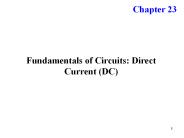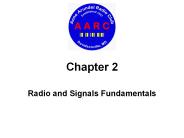Electrical Fundamentals PowerPoint PPT Presentations
All Time
Recommended
Fundamentals of Electrical Testing Derek Lindberg Jason Shin What and Why? Electrical testing is intended to guarantee that a given device is electrically functional ...
| PowerPoint PPT presentation | free to view
Electrical Fundamentals I Laboratory Lab 1. Current and Voltage Characteristics Student Name, Student Name Electronics & Renewable Energy Engineering
| PowerPoint PPT presentation | free to view
Fundamentals of Electromagnetics: A Two-Week, 8-Day, Intensive Course for Training Faculty in Electrical-, Electronics-, Communication-, and Computer- Related ...
| PowerPoint PPT presentation | free to download
Fundamentals of Electromagnetics: A Two-Week, 8-Day, Intensive Course for Training Faculty in Electrical-, Electronics-, Communication-, and Computer- Related ...
| PowerPoint PPT presentation | free to download
What is Lenz law? 2.16. ... of Time-Varying Electric and Magnetic Fields Hertzian Dipole Radiation from Hertzian Dipole 2.5 Gauss Laws (EEE, Sec. 2.5 ...
| PowerPoint PPT presentation | free to download
Fundamentals of Electromagnetics for Teaching and Learning: A Two-Week Intensive Course for Faculty in Electrical-, Electronics-, Communication-, and Computer ...
| PowerPoint PPT presentation | free to download
Fundamentals of Electromagnetics for Teaching and Learning: A Two-Week Intensive Course for Faculty in Electrical-, Electronics-, Communication-, and Computer ...
| PowerPoint PPT presentation | free to download
Fundamentals of Electromagnetics for Teaching and Learning: A Two-Week Intensive Course for Faculty in Electrical-, Electronics-, Communication-, and Computer ...
| PowerPoint PPT presentation | free to download
Fundamentals of Electromagnetics for Teaching and Learning: A Two-Week Intensive Course for Faculty in Electrical-, Electronics-, Communication-, and Computer ...
| PowerPoint PPT presentation | free to download
Fundamentals of Electromagnetics for Teaching and Learning: A Two-Week Intensive Course for Faculty in Electrical-, Electronics-, Communication-, and Computer ...
| PowerPoint PPT presentation | free to download
Fundamentals of Electromagnetics: A Two-Week, 8-Day, Intensive Course for Training Faculty in Electrical-, Electronics-, Communication-, and Computer- Related ...
This online electrical engineering course about Revit training elaborates the fundamentals of the Basic Revit Electrical tool and will give you the skills necessary for modeling, detailing, and visualization for Electrical engineering.
| PowerPoint PPT presentation | free to download
presentation about electrical actuation devices such as relay, solenoids, contactors, over load relays, MCB and DOLS
| PowerPoint PPT presentation | free to download
Engineering Fundamentals
| PowerPoint PPT presentation | free to view
Roofing Industry Partnership Electrical Safety Training Objectives After completing this unit, you will: Be familiar with the fundamental concepts of electricity.
| PowerPoint PPT presentation | free to view
Electrical Engineering
| PowerPoint PPT presentation | free to download
Electrical Charge Some Concepts: Electrical charge ( ); Electric field ( ); Electric current ( ); Conductor ( ); Semiconductor ( ...
| PowerPoint PPT presentation | free to download
Chapter 1 Mechanical and Electrical Fundamentals. Tour Logistics ... First Electromagnet Sturgeon 1825. First E-M Induction Generator DC Faraday 1831 ...
| PowerPoint PPT presentation | free to view
Electrical Safety
| PowerPoint PPT presentation | free to view
Every do-it-yourselfer who wants to venture into the world of auto electrical repairs needs to be well-versed in key components. Knowing these components gives you the ability to effectively handle routine maintenance activities as well as typical concerns. Lets examine the 9 vital auto electrical components in more detail since they are crucial to your cars operation. You can explore our products at our website:- https://www.ozautoelectrics.com/.
| PowerPoint PPT presentation | free to download
ENGR 107: Engineering Fundamentals Lecture 1: The Engineering Profession C. Schaefer Department of Electrical and Computer Engineering George Mason University
| PowerPoint PPT presentation | free to view
Transmission Fundamentals & Principles Shannon, assumes the noise to be white noise , therefore, the wider the bandwidth, the more noise is admitted into the ...
| PowerPoint PPT presentation | free to view
FE Exam Review Electrical Circuits LT Aaron Still P.E. in Electrical Engineering Exam Strategies http://www.ncees.org/exams/fundamentals/ Only 4 minutes per problem.
| PowerPoint PPT presentation | free to view
... with a line voltage higher than 120V and only reset if you know why it tripped ... Trip range 4-6ma - Monthly test. Electrical. Safety. Electrical ...
| PowerPoint PPT presentation | free to view
The Fundamentals of Engineering (FE) exam will make you eligible for becoming a licensed engineer in your chosen field. Recent graduates and students close to completing an undergraduate degree can sit for this exam and get a professional certification for carrying out engineering work. Before your FE Electrical Exam Preparation, you must learn about the process of examination and how it will be conducted.
| PowerPoint PPT presentation | free to download
NETWORKING FUNDAMENTALS Selected Concepts WHAT IS A NETWORK? A network is simply two or more computers that are linked together. The most common types of networks are ...
| PowerPoint PPT presentation | free to view
The Fundamentals of Engineering (FE) exam will make you eligible for becoming a licensed engineer in your chosen field. Recent graduates and students close to completing an undergraduate degree can sit for this exam and get a professional certification for carrying out engineering work. Before your FE Electrical Exam Preparation, you must learn about the process of examination and how it will be conducted.
| PowerPoint PPT presentation | free to download
Fundamentals of Ultrasonics Piezoelectric Properties Anisotropic Notation: direction X, Y, or Z is represented by the subscript 1, 2, or 3, respectively, and shear ...
| PowerPoint PPT presentation | free to view
Fundamentals of Computer Networks ECE 478/578 Lecture #1 Instructor: Loukas Lazos Dept of Electrical and Computer Engineering University of Arizona
| PowerPoint PPT presentation | free to download
Digital Transmission Fundamentals Pulse Code Modulation (PCM) sampling an analogue signal quantisation : assigning a discrete value to each sample
| PowerPoint PPT presentation | free to view
This PowerPoint presentation provides comprehensive information about Meggers, essential instruments for electrical insulation resistance testing. This PPT is designed to enhance your understanding of Meggers, ensuring the safety and reliability of electrical systems. Ideal for electrical professionals seeking to improve their knowledge and practices.
| PowerPoint PPT presentation | free to download
Chapter 4 Electricity Local Shock Know Chart As you correct your answers, evaluate your progress. Create a Know Chart with 2 columns. Place correct answers from the ...
| PowerPoint PPT presentation | free to download
OFDM Physical Layer -- Fundamentals, Standards, & Advances K. Giridhar Associate Professor of Electrical Engineering Telecom and Computer Networks (TeNeT) Group
| PowerPoint PPT presentation | free to view
Fundamentals of Electrochemistry CHEM*7234 / CHEM 720 Lecture 1 Course Overview Date Thurs 8 Fri 9 Mon 12 Tues 13 Wed 14 Thurs 15 Fri 16 Mon 19 Tues 20 Wed 21 Thurs ...
| PowerPoint PPT presentation | free to download
Engineering Fundamentals and Problem Solving, 4th Edition, Eide, Jenison, Mashaw, ... 'Engineering in History', Richard Shelton Kirby, et al, Dover, 1990. ...
| PowerPoint PPT presentation | free to view
Electrical Safe Work Practices
| PowerPoint PPT presentation | free to view
EEE358S Fundamentals of Communications Engineering Emmanuel O Bejide ebejide@ebe.uct.ac.za http://www.uct.ac.za/depts/staff/rebejide/ Department of Electrical Engineering
| PowerPoint PPT presentation | free to view
Fundamentals of Atomic Structure
| PowerPoint PPT presentation | free to download
Fundamentals of Electric Circuits Chapter 1 Basic Concepts
| PowerPoint PPT presentation | free to view
... High Voltage Breaker A circuit breaker is an automatically-operated electrical switch designed to protect an electrical circuit ... for personnel safety ...
| PowerPoint PPT presentation | free to view
Fundamentals of Ultrasonics Ultrasonics Definition: the science and exploitation of elastic waves in solids, liquids, and gases, which have a frequency above 20KHz.
| PowerPoint PPT presentation | free to view
This presentation provides information on Basic Electrical Engineering and AC fundamentals. It is presented by Prof. A. B. Kasar, from the department of Applied Sciences and Engineering at International Institute of Information Technology, I2IT. The presentation discusses Definition of Alternating Quantity, RMS or Effective Value, Average Value, Phasor Representation, AC circuit with a pure resistance, pure Inductance and pure Capacitance.
| PowerPoint PPT presentation | free to download
Automatic Transmission Fundamentals Chapter 73 Objectives Identify the basic parts of an automatic transmission Describe the operation of the major sections of an ...
| PowerPoint PPT presentation | free to download
Hands-on Networking Fundamentals Chapter 2 How LAN and WAN Communications Work
| PowerPoint PPT presentation | free to view
Fundamentals of Heat Transfer Conduction, Convection, and Radiation Heat Transfer Mode Heat transfer (or heat) is thermal energy in transit due to a temperature ...
| PowerPoint PPT presentation | free to view
Our expert Electrical and gadgets building group has got incredible involvement in Electrical and hardware designing exploration and usage. They are broadly known and recognized for the homework help on Electrical and gadgets designing related, and have distributed various online Electrical and hardware building articles.
| PowerPoint PPT presentation | free to download
CIS 1140 Network Fundamentals Chapter 5 Topologies and Ethernet Standards Collected and Compiled By JD Willard MCSE, MCSA, Network+, Microsoft IT Academy ...
| PowerPoint PPT presentation | free to view
Provides continuous power to electrical equipment even if one phase is damaged ... Lead-acid battery is the most common, can be charged by forcibly changing the ...
| PowerPoint PPT presentation | free to view
redox reactions fundamentals of electrochemistry electrochemistry is the branch of chemistry that deals with the relationship between electricity and
| PowerPoint PPT presentation | free to view
Like water, electricity will take the path of least resistance. ... instead of a human body unless the body presents a path of lower resistance. ...
| PowerPoint PPT presentation | free to view
Emergency and Level 2 Electrical Contractors Sydney 24 hours in a day available. Call Professionals whenever you need and get A-grade Services.
| PowerPoint PPT presentation | free to download
The DC may have long term adverse physiological effects) ... General Therapeutic Uses of Electricity Contraindications of Electrotherapy Terms of electricity ...
| PowerPoint PPT presentation | free to download
Environmental Fundamentals of Alternatives Presentation for CEA/NRCan Workshop: Diversifying the Mix - Alternatives to Conventional Generating Technology
| PowerPoint PPT presentation | free to view
Chapter 23 Fundamentals of Circuits: Direct Current (DC) *
| PowerPoint PPT presentation | free to download
Chapter 2 Radio and Signals Fundamentals Radio and Signal Fundamentals Radio Equipment Basics A repeater is a station that transmits a received signal simultaneously ...
| PowerPoint PPT presentation | free to download
Fundamentals of Electricity Circuits 1 Fall 2005 Harding University Jonathan White Outline Benjamin Franklin / History of Electronics Atoms/Electrons Electron shells ...
| PowerPoint PPT presentation | free to view
























































